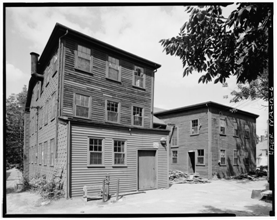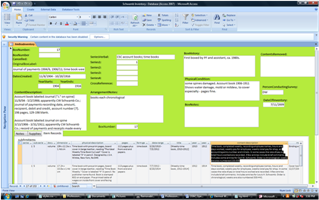what's new
Old Schwamb Mill business records 1864-1920, rehoused and described
Working with Old Schwamb Mill Archivist Margaret Clarke, I recently completed a finding aid for the Mill's oldest documents, its business records. The work was funded by a Research in Inventory Grant (RIG) from Mass Humanities. Mass Humanities offers the RIG as a means to process portions of a document collection so that research on a particular project can be carried out.
 |
The underlying rationale for obtaining this grant was to organize the business records kept by the Old Schwamb Mill in Arlington, Mass., so that a research database of the Mill's known workers can be prepared.
The Clinton W. Schwamb Company (1904-1969), located at Mill Lane in Arlington, Massachusetts, was one of a succession of frame manufacturing businesses run by the Schwamb family. Charles (Karl) Schwamb (1828-1903) and Frederick Schwamb (1835-1905), two of five brothers who emigrated from Germany in the mid-1800s, started Charles Schwamb and Company in 1864. The company manufactured round and oval picture frames and straight moulding, and operated in a former spice mill built on Mill Brook in 1861, at a mill site that had been in use since the 1600s. In 1970, the mill building with much of its machinery and stock was acquired by the Schwamb Mill Preservation Trust. Since 1970, the Trust has operated the mill as a living-history museum that continues to produce and sell oval frames.
 |
The Schwamb Mill, Arlington, Mass., ca. 1940 |
After an inventory of the Mill's archival holdings, all known business records at the Mill from 1864-1920 were processed. It turned out that the the extant records of workers at the Mill are for the years 1904-1920 and beyond. While no personnel records in the modern sense were found, weekly time books, shift schedules, notes on completed orders, accident reports, and payroll records (even as cash entries only) all provide important information for the project.
Here is a summary of the work accomplished as part of this Research in Inventory Grant.
The project director and I surveyed archival holdings of the Mill. Of these, over half were Museum-era records post 1969.
We assigned box numbers to the pre-1969 business records (approximately 150 containers plus unboxed records and drawings) and assessed these in detail to about 1950. I focused specifically on all records prior to 1920 and, in addition, entered all box assessments in a database.
Four distinct collections were suggested by the assessment of the business records. On the basis of the assessment, I drafted a series structure and presented it to the project director. After discussion, we adopted the series structure for use in the Clinton W. Schwamb Collection.
The collection is arranged in ten series:
- Account Books and Ledgers
- Accounts Payable
- Accounts Receivable
- Frame and Moulding Orders
- Frame and Moulding Designs
- Correspondence
- Operations
- Images
- Other Records
- Period Publications
I then processed records 1864-ca. 1920 completely, that is:
- arranged the documents in the series structure;
- cataloged the documents as archival records;
- measured and physically described the documents (chiefly the books) as museum items;
- assessed the documents for conservation needs.
The cataloged items were also specifically assigned to new acid-free archival housings (folders, over-size flat files, document and clam-shell boxes).
 |
Data entry form (click to enlarge) |
To facilitate the project, I built an Access database which allowed me to
- assess boxes of materials while recording original labels, date ranges, possible series assignments, conservation information, etc.
- review assessed materials and assign new archival housing to them;
- enter separate notes on content while assessing materials, for example, evidence of workers at the mill, references to members of the Schwamb family, connections to other records, etc;
- create catalog entries for specific items and connect each item to the series descriptions;
- create reports of assessed or cataloged items by date, series, etc.
- query the box records or catalogued items to locate records.
The database continues in use as we continue to process the material.
I wrote the finding aid, including introductory notes and all series descriptions. We expect to revise the finding aid as we process the rest of the collection. In the course of assessing the material, many box descriptions post-1920 include items which are all-but-cataloged. For example, in Series 4, frame and moulding orders have been assessed to 1969 and are in a straight-forward numbered sequence.